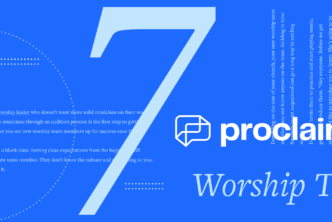Today’s guest post is by Poncho Lowder, pastor at City Bible Church in Portland, OR, cofounder of the Bible and Journal App Company, and author of Pursue God: How Do You Develop a Thriving Relationship with God? Today, he writes about how to engage a fast-paced postmodern culture.
In part 1 we discussed the importance of understanding the new communication values of culture today: flexibility, mobility, and inclusivity. Today we’ll discuss how these three communication values apply to the church specifically.
The local-church challenge: let’s take a look at some ways churches can better apply flexibility, mobility, and inclusivity to how they connect with people today. (These are meant to be a starting point, not an all-inclusive list).
1. Announcements
The challenge every church faces with the classic way of doing announcements is that it takes up precious time in middle of the service, people are often disconnected, and 1/3 of people will miss them that week (the average church attendance is at 64% each week). Many churches put their announcements on their website, which is good, but they are rarely checked by people in their church community.
We recommend making announcements interactive with something like Proclaim in combination with an electronic newsletter, delivered at the same time each week. This allows you to keep your Sunday service announcements short and to the point. But most importantly, it works great within the communication values of today’s culture. People can look (and relook) at it when they want, it’s mobile friendly, and if done right, it has a place in it for people to ask questions and share their opinions. It can also incorporate “social share,” which means people can share it on social media if they desire. Faithlife, the community and collaboration tool that undergirds Proclaim, has an elegant and easy-to-use newsletter feature that enables you to craft a weekly newsletter for your congregation, and best of all it’s completely free!
2. Giving
The giving culture in churches greatly differs from church to church, but regardless, there are ways to better connect people with your desired practice of generosity.
Statistics show that 80% of men do not carry a checkbook today, and with both males and females cash is becoming very rare in today’s credit- and debit-card culture. This reality means giving in church is not as convenient as it once was. It’s time to go online and mobile with your giving! Many churches have recently seen their online and mobile giving account for over 50% of all giving. The keys are a recurring giving feature, a mobile app with giving, and a website that is resizable. This allows people to give whenever they want, even from their phones. Whether it’s payday or after church when they get home, mobility makes giving easy.
Mobile apps today are affordable, easy to use, and include online giving.
3. Website
It’s time to go resizable! “Resizable” (sometimes referred to as “responsive”) simply means the website will adjust sizing perfectly based on the device used to access the website. This means on your phone browser, everything is easy to see and read. When you open the website on a tablet or PC, you’ll have a view that is also perfectly sized, regardless of your monitor size.
Currently, most church websites have a 25–30 percent mobile-viewing percentage; churches in larger cities have as high as 40 percent. This means around 1/3 of people that come to their website have a bad viewing experience if it’s not resizable. If you have just a classic website, mobile viewers will struggle to navigate the site because things are too small to read and hard to find. This will greatly impact the website’s use and your ability to connect with those using it.
You can upgrade your current website to be a resizable one fairly easily.
Start making improvements today
Take some time today to think through flexibility, mobility, and inclusiveness in the context of your church. The goal is to discern how to better connect your church with the culture around you by adjusting at the mediums you use, but not changing the timeless gospel message.
Some changes can be big and costly, but others are small and simple. What’s important is to discern what is a “good thought” and what is a “God thought” for your church to focus on this year.
We would love to hear your opinions, questions, or experiences on this topic. Please feel free to share your thoughts on this post.




